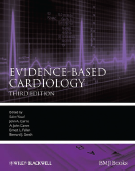By the very nature of book publishing, a relevant evidence-based textbook is always a hard task to achieve. The editors of Evidence-based cardiology preface this book, now in its 3rd edition, with an admission of this limitation. This textbook is, however, more than just a reference volume. It seeks to educate and equip the reader with the tools to critically appraise information, and then demonstrates how research has evolved to shape current practice.
Editors: Yusuf S, Cairns J, Camm J,
Fallen EL, Gersh BJ
Publisher: Wiley-Blackwell,
Oxford, 2010
ISBN: 978-1-4051-5925-8
Price: £180
 The book begins with an understanding of evidence-based decision making. Diagnostic screening and testing are evaluated, and the fundamentals of statistical analyses are explained. The success of this section is the use of examples from within cardiovascular medicine, which even the most casual observer would have familiarity with. Health economics and implementation are also explored, and serve to further contextualise the translation from clinical trial to real world medicine.
The book begins with an understanding of evidence-based decision making. Diagnostic screening and testing are evaluated, and the fundamentals of statistical analyses are explained. The success of this section is the use of examples from within cardiovascular medicine, which even the most casual observer would have familiarity with. Health economics and implementation are also explored, and serve to further contextualise the translation from clinical trial to real world medicine.
It is also in this first part that two new features are seen. Firstly, the evidence for risk assessment and reduction in non-cardiac surgery is addressed. Useful management information is contained within this chapter, and it sits awkwardly in the section dedicated to general concepts. Nonetheless, the evidence reviewed is comprehensive and up-to-date. The second is concerned with employment fitness standards. It uses the aviation industry to illustrate the interface of evidence, risk and statistics, but neither seeks, nor delivers a review of standards across all industries.
The second section of the book looks at the prevention and management of cardiovascular disease. Primary prevention, epidemiology and genetics are discussed. It was useful to find a chapter on psychosocial influence and cardiovascular disease, highlighting the lack of attention these modifiable risk factors face when clinical trials in this field have inherent limitations.
The third part contains well-constructed chapters on disease management. Many illustrate not only the way in which emerging evidence has shaped our management, but the clinical trials that have developed to answer the emerging questions. However, this is by no means a quick reference guide to management. There are few flow charts, protocols and guidelines and a reader seeking step-by-step treatment would want to look elsewhere. What is provided is a comprehensive overview of the evidence that serves the reader with a tool for clinical decision making.
The book concludes with a useful selection of vignettes, each with the reader being guided through the clinical application of the evidence, explored by different authors earlier in the book. Many of the same arguments are, therefore, rehearsed but the diseases chosen are important, and such repetition only serves to highlight appropriate practice.
The editors remind us of the dictum that clinical decision making combines evidence with clinical expertise and awareness of patients’ needs and preferences. This book certainly gives a framework by which to implement this. This comprehensive review is recommended both for trainees undergoing assessment and more experienced cardiologists seeking to reference their current practice. Even if the evidence becomes no longer current, there is enough here to support decision making well into the future.
James Rosengartan
SpR Cardiology
Portsmouth Hospitals NHS Trust, Portsmouth, PO6 3LY.
